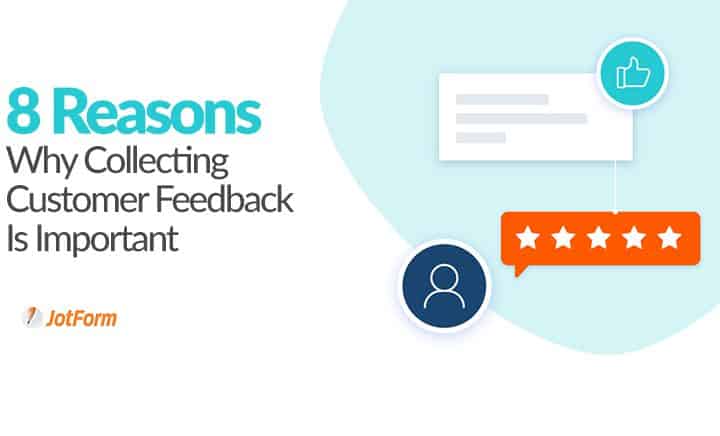All too often, business owners get trapped in the bubble of their own company. In the desire to stay ahead of the competition, they can become completely oblivious to the most important opinion of all — the customer’s.
How do you remain cognizant of how your customers are feeling? Ask them. And one of the best ways to do that is to create a survey.
Customer feedback, both positive and negative, will help you improve the customer experience, increase retention, and enhance the quality of your products and services.
In this post, we’ll detail eight reasons why collecting and analyzing customer feedback is important for your business in 2022.
1. Quantify customer satisfaction
Perhaps the most obvious benefit of collecting customer feedback is to measure customer satisfaction. When a customer leaves the store smiling or receives their package without complaint, we assume they’re satisfied. However, once our item or service reaches them, we often have no idea how they truly feel.
For every customer who bothers to complain, 26 other customers remain silent. With that ratio, business owners are hardly aware of customer dissatisfaction. On top of that, 96 percent of unhappy customers won’t complain. However, 91 percent of those customers will simply leave and never come back.
Collecting customer feedback is a simple method of learning how your customers feel about your business, including what they like and dislike. Analyzing the results of these surveys helps business owners better understand their target audience and optimize their service to better accommodate less-than-satisfied customers.
2. Improve products and services
Being entrenched in your business can make it difficult to identify flaws in products or services. You and your employees are constantly surrounded by these items, which makes you less objective. When you open yourself up to customer feedback, you get a third-party perspective of the company that can pick up on things you’ve missed.
Consider this quote by Kristin Smaby from the article Being human is good business, “When customers share their story, they’re not just sharing pain points. They’re actually teaching you how to make your product, service, and business better.”
3. Make customers feel valued and involved in the business
When your customers choose to spend their money on your products, it’s important that you make them feel valued. The people who chose you over your competitor want to feel appreciated for their decision and as if they’re involved with your operations.
Think of it this way: 64 percent of people find customer experience more important than price when it comes to making a purchase. And 66 percent of adults feel that valuing their time is the most important thing a company can do to provide them with good online customer experiences.
As opposed to viewing your customers as a closed sale, view them as partners who can help inform smart business decisions. Collecting and analyzing their feedback will help you tailor your services to fit their needs.
4. Create a better customer experience
Let’s face it. No business is perfect all the time. Luckily, a successful business isn’t judged by how many customer experiences they get wrong, but rather how many of these experiences they’re able to make right.
Research has shown that 70 percent of customers who have issued a complaint will do business with you again if you resolve the complaint in their favor. That percentage skyrockets to 95 percent of customers if you resolve the complaint instantly.
The only way to determine when customers have a complaint and provide them a proper avenue to discuss their frustrations is by issuing customer feedback surveys. Efficient review and analysis of these results can help you right any wrongs, likely retaining or regaining a customer.
5. Amplify customer retention efforts
Small hiccups, like slow page loading time or long lines in store, can gradually build up over time. The more these instances accumulate, the more likely it is for a customer to switch to a competitor. In fact, 50 percent of customers have left a brand for a competitor who was able to stay more relevant and better satisfy their needs.
As an added incentive to improve customer retention, increasing retention rates by 5 percent can increase profits anywhere from 25 to 95 percent.
6. Create brand advocates
Brand advocates are customers who are willing to talk about your products and services unprompted. For example, they might create user-generated content (UGC) or provide testimonials for your brand.
Pro tip: UGC-shared posts are a marketer’s dream. As studies have shown, this type of content has a 28 percent higher engagement rate compared to standard posts. And it’s also two times as likely to be shared.
Word-of-mouth marketing via brand advocates has been shown to increase marketing effectiveness by as much as 54 percent.
7. Appear desirable to new customers
While collecting and analyzing customer feedback can increase the satisfaction of existing customers, it’s also ideal for acquiring new customers. Feedback from actual customers is a reliable source of information for future buyers. Information mined from surveys can provide testimonials, reviews, and referrals on social media or review platforms.
A stunning 97 percent of potential buyers have admitted that online reviews influence their decision to make a purchase or walk away.
8. Benchmark the success of business decisions
Referring back to an earlier point, customer feedback is an excellent method of determining what customers like and dislike about your company. This insight can inform a variety of business decisions, from changes to the website to an overhaul of a store’s layout. However, it can be difficult to tell if these changes made much difference in satisfaction by analyzing sales alone.
Customer feedback serves as a benchmark for the success of business updates. Upon rolling out any bug fixes or physical changes, it’s important to consult existing customers and gain insight from new customers.
In a world where half of shoppers believe their feedback doesn’t go to anyone who will act on it, show your customers that their voice makes a difference to you.
Ideally, every business should use a customer feedback loop to improve operations and increase satisfaction. Collect feedback, analyze your results, implement improvements, and repeat. By continuously keeping a pulse on customer satisfaction, you’ll likely have happier customers and make more money.







